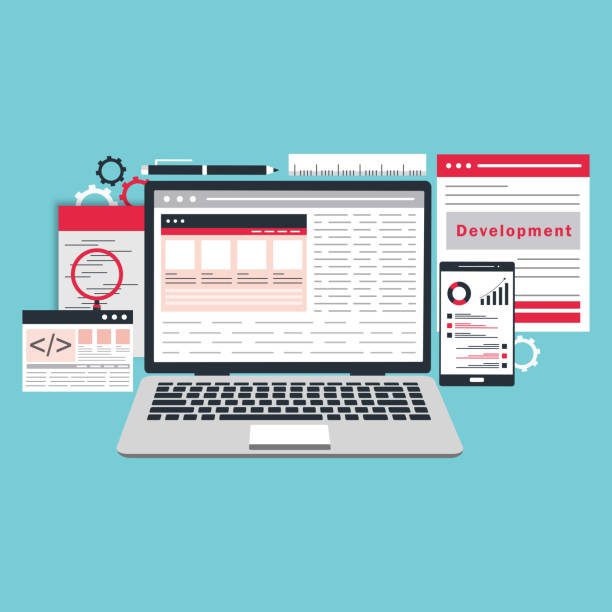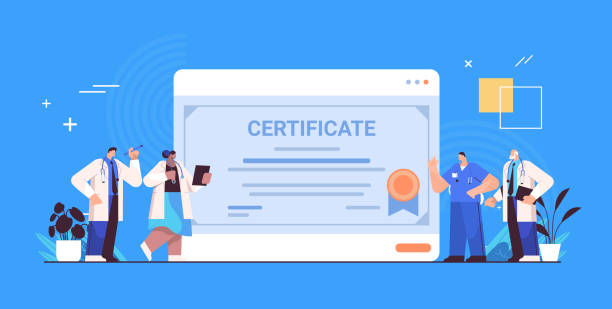Introduction to Fast Website Design and its Importance in the Digital Age

In today’s fast-paced world, speed is paramount.
Users expect websites to load in a fraction of a second, and if this doesn’t happen, they quickly leave the page and go to your competitor.
This is where the importance of #Fast_Website_Design becomes more evident than ever.
User Experience (UX), SEO and even conversion rates, all depend on website loading speed.
A slow website not only disappoints users but can also lower your ranking in search engines and, literally, cause you to lose potential customers.
In this article, we will comprehensively examine key factors in fast website design, tools, and optimization techniques so you can build a website with outstanding performance.
This guide will help you optimize your website for speed and efficiency from the very beginning by adopting the right approaches.
Our goal is to provide explanatory and educational content that assists you in achieving this.
Are you tired of your company’s website not meeting your expectations? With Rasavab, design a professional website that truly represents your business.
✅ Increase new customer acquisition and sales leads
✅ Boost your brand’s credibility and trust with your audience
⚡ Get a free website design consultation!
Key Factors Affecting Website Loading Speed

To achieve fast website design, understanding the factors affecting site loading speed is crucial.
The first factor is server response time.
The faster the server responds to browser requests, the quicker the loading process begins.
The second factor is optimizing images and multimedia files; heavy images can significantly reduce site speed.
Using appropriate formats (such as WebP) and proper compression is essential.
The third factor is Caching, which helps temporarily store data and prevents full page reloads.
The fourth factor is Minification of CSS and JavaScript files, which removes whitespace and comments.
Finally, using a Content Delivery Network (CDN) to distribute content from servers closer to the user significantly increases speed.
Understanding these factors is essential for any effort to improve site speed and is a significant part of the specialized and educational content in this field.
Choosing the Right Platform and Tools for Fast Website Design

Choosing the right platform is one of the most important decisions on the path to fast website design.
Content Management Systems (CMS) like WordPress, Joomla, or Drupal, by offering optimized plugins and themes, can help you build a high-speed site.
In contrast, Drag-and-Drop Builders like Wix or Squarespace, while offering high ease of use, may generate extra code and affect speed.
For ultimate speed, static site generators like Hugo or Jekyll are excellent options, as they produce pure HTML pages that do not require server-side processing.
The guidance and educational part of this chapter helps you choose the best tool considering your project needs.
Each platform has its specific advantages and disadvantages in terms of speed, which must be carefully considered.
This initial choice will significantly impact your ability to achieve fast and optimized website design.
| Platform | Ease of Use | Speed Potential | Flexibility |
|---|---|---|---|
| WordPress | Medium to High (with themes and plugins) | High (with proper optimization) | Very High |
| Site Builders (Wix, Squarespace) | Very High | Medium (extra code) | Medium |
| Static Site Generators (Hugo, Jekyll) | Medium to Low (requires technical knowledge) | Very High (pure HTML) | High |
The Impact of Web Hosting and Infrastructure on Website Speed

The role of Web Hosting in fast website design is undeniable.
Choosing unsuitable hosting can nullify all your optimization efforts.
Shared hosting, while cost-effective, shares server resources with other websites, leading to reduced speed during peak hours.
For faster website design, using a Virtual Private Server (VPS) or Dedicated Server, which provide independent resources, is recommended.
Cloud Hosting, with its high flexibility and scalability, is also an excellent option for high-traffic websites.
In addition to the type of hosting, the physical location of the server is also important; the server should be as close as possible to your target audience to reduce latency.
A strong hosting infrastructure, including SSDs, powerful processors, and sufficient bandwidth, is the foundation of a high-speed website.
This specialized and analytical aspect is a crucial step in building a high-performance website.
Unhappy with your e-commerce site’s low sales?
Rasavab is your solution for a professional and high-selling e-commerce site.
✅ Significant increase in sales and revenue
✅ Easy and enjoyable shopping experience for customers
⚡ Get a free consultation from Rasavab now!
Optimizing Images and Multimedia Content for Speed

Images and multimedia content often constitute the largest data volume on a website, which is why their optimization plays a key role in fast website design.
The first step is compressing images without significant quality loss.
Online tools and CMS plugins can be helpful in this regard.
Using modern formats like WebP instead of JPG or PNG can significantly reduce file size.
The next point is Lazy Loading; this technique ensures that images and videos are only loaded when the user scrolls to the relevant section, not immediately upon page entry.
Also, creating Responsive Images using the srcset attribute in HTML ensures that the browser loads the most appropriate image size for the user’s device.
This guidance and specialized approach not only increases loading speed but also helps improve user experience across various devices.
Improper optimization can lead to a slow website, even if you have adhered to other aspects of fast website design.
Optimizing Code and Scripts for High Performance

In addition to images and hosting, website coding and scripts also play a significant role in fast website design.
Minification of CSS and JavaScript files means removing whitespace, comments, and unnecessary characters from the code, which reduces file sizes and increases download speed.
Concatenation of multiple CSS or JavaScript files into a single file reduces the number of HTTP requests, which is very beneficial for speed.
Another crucial technique is Asynchronous Loading of JavaScript scripts.
This allows the browser to continue rendering page content simultaneously with loading scripts, preventing render-blocking.
Optimizing the CSS delivery method is also important; critical CSS can be directly placed in the <head> tag to ensure above-the-fold content is displayed faster.
These specialized and educational aspects of clean and efficient coding are the cornerstone of a fast and powerful website design and also send positive signals to search engines.
Caching Strategies and the Role of CDN in Fast Website Design

Caching and the use of a Content Delivery Network (CDN) are two main pillars in fast website design strategy.
Browser Caching allows the user’s browser to store static files (such as images, CSS, and JS) for subsequent visits, resulting in instant page loading.
Server-Side Caching also stores the results of complex processing so that future similar requests do not require re-processing.
Object Caching is also useful for websites that use complex databases.
Alongside caching, CDNs, by distributing copies of your website’s content across multiple servers worldwide, ensure that users access content from the closest possible server.
This significantly reduces latency and increases loading speed.
The combined use of these specialized and guiding strategies will transform your website into an excellent example of fast and optimized website design, providing a flawless user experience.
| Caching Type | Description | Benefits for Speed |
|---|---|---|
| Browser Caching | Storing static files (images, CSS, JS) on the user’s computer | Increased speed for repeat visits, reduced server load |
| Server-Side Caching | Storing output of pages generated by the server | Reduced server response time, lower resource consumption |
| Object Caching | Storing results of database queries or complex calculations | Accelerated database operations, improved performance of complex applications |
Mobile Responsiveness and the Role of AMP in Fast User Experience

In the current era, where most users access the internet via smartphones, Mobile Responsiveness is no longer an advantage, but a necessity for fast website design.
A website that doesn’t display well on mobile and doesn’t load quickly not only loses users but also drops in search engine rankings.
The AMP project (Accelerated Mobile Pages), launched by Google, is a solution for building ultra-fast pages for mobile.
AMP pages load at lightning speed by eliminating unnecessary elements and using a restricted HTML/CSS/JS framework.
This is especially beneficial for news and content-driven websites.
Google also prioritizes AMP pages in its search results and displays them with a special icon.
This explanatory and informative approach demonstrates how focusing on mobile users and utilizing technologies like AMP can revolutionize user experience and lead to successful fast website design.
Losing potential customers due to an unprofessional website? Rasavab is your answer! With our specialized corporate website design services:
✅ Enhance your business’s credibility and standing
✅ Experience more targeted customer acquisition
⚡ Act now to get a free consultation!
Tools and Methods for Monitoring and Testing Website Speed

After implementing all fast website design techniques, the final stage is continuous monitoring and testing of website speed.
Various tools are available for this purpose to help you evaluate your site’s performance and identify potential issues.
Google PageSpeed Insights is one of the most popular tools, providing performance scores for mobile and desktop and offering suggestions for speed improvement.
GTmetrix and Pingdom Tools are also powerful tools that display more details about loading time, HTTP requests, and the performance of each element on the page.
Correct interpretation of the results from these tools and acting on their recommendations is crucial for maintaining and continuously improving your website speed.
This guidance and educational section enables you to always ensure your fast website design and quickly resolve any issues that arise.
Regular monitoring not only helps identify problems but also allows you to measure the impact of implemented changes.
The Future of Fast Website Design and Emerging Trends

The world of web is constantly changing, and fast website design is no exception.
Google, with the introduction of Core Web Vitals, has introduced new metrics for evaluating user experience and site speed, whose importance in SEO is growing daily.
These metrics include Largest Contentful Paint (LCP), Cumulative Layout Shift (CLS), and First Input Delay (FID).
Emerging trends such as Progressive Web Apps (PWAs), which offer a combination of the best features of websites and mobile applications, promise a bright future for ultra-fast websites.
Artificial intelligence (AI) will also play an increasing role in image optimization, caching automation, and even predicting performance issues.
This analytical and thought-provoking content helps you look into the future of fast website design and prepare yourself for upcoming changes.
By staying updated with these changes, you can ensure that your website always remains at the forefront of the competition and provides the best experience for users.
Frequently Asked Questions
| Question | Answer |
|---|---|
| What is fast website design? | It refers to the process of building a website with high loading speed and optimized for excellent performance. |
| Why is website speed important? | Website speed directly impacts user experience, conversion rates, SEO, and search engine rankings. |
| What are the factors affecting website speed? | Image size, optimized coding, CDN usage, caching, choosing suitable hosting, and the number of plugins. |
| How can website loading speed be increased? | Optimizing images, compressing files (CSS, JS, HTML), using browser cache, reducing redirects, and using a CDN. |
| What is CDN and how does it help website speed? | A Content Delivery Network (CDN) stores your site’s content on various geographical servers and delivers it from the closest server to the user. |
| What is the role of hosting in website speed? | The quality and type of hosting (shared, VPS, dedicated) significantly impact server response time and, consequently, website loading speed. |
| Does using too many plugins reduce website speed? | Yes, each plugin loads additional code that can lead to site slowdowns. Choosing optimized and essential plugins is recommended. |
| How to optimize images for increased website speed? | Compressing images without losing quality, using modern formats (WebP), setting correct dimensions, and Lazy Loading. |
| How does Caching help website speed? | Caching helps temporarily store site content in the user’s browser or on the server, so the site loads faster on subsequent visits. |
| What are the best tools for checking website speed? | Google PageSpeed Insights, GTmetrix, and Pingdom Tools are among the common and practical tools for analyzing and improving website speed. |
And other advertising services of Rasavab Advertising Agency
Smart Social Media: Professional optimization for digital branding using key page optimization.
Smart Digital Branding: A combination of creativity and technology for campaign management through attractive UI design.
Smart Direct Marketing: Professional optimization for increasing sales using custom programming.
Smart Data Analysis: A combination of creativity and technology for customer acquisition through custom programming.
Smart Brand Identity: Revolutionize campaign management with precise audience targeting.
And over hundreds of other services in internet advertising, advertising consultation, and organizational solutions
Internet Advertising | Advertising Strategy | Sponsored Content
Resources
Comprehensive Web Design Guide
Website Performance Optimization Tips
Website Speed Increase Tricks
Comprehensive Web Design Articles
Are you ready to transform your business in the digital space? Rasavab Afarin Digital Marketing Agency, by offering specialized and integrated solutions, including advanced WordPress website design services, helps you establish a powerful and prominent presence in the online world.
📍 Tehran, Mirdamad Street, next to Bank Markazi, Southern Kazeroon Alley, Ramin Alley, Plaque 6



